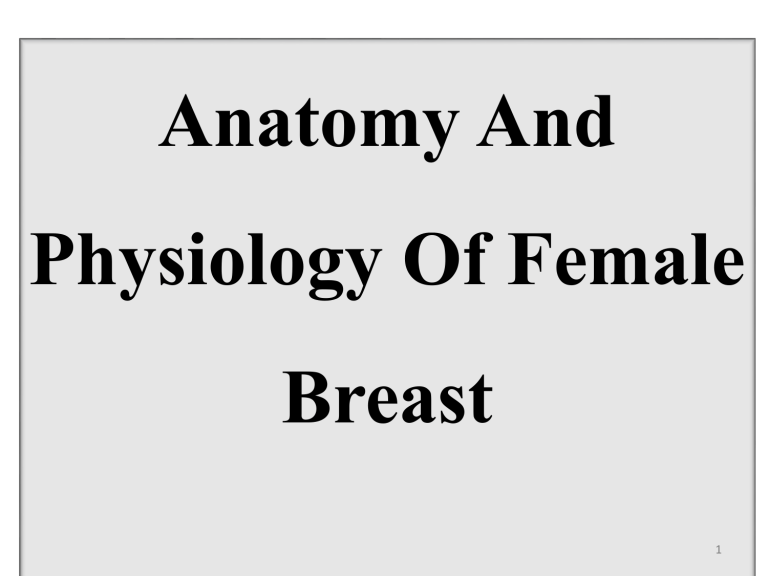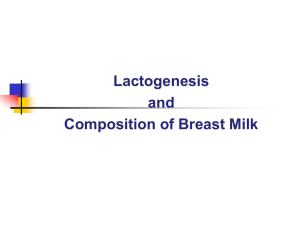
Anatomy And Physiology Of Female Breast 1 MAMMARY GLAND/THE BREAST The breasts are large, modified sebaceous glands. Bilateral Extends from the 2nd to 6th rib in the midclavicular line. Lies in the subcutaneous tissue over the fascia covering the pectorals major muscle. 2 B A (A) Structure of the basic unit of the mammary gland;. (B) Structure of adult female breast 3 4 The endocrine control of lactation and preparation of the breast for lactation divided into following stages: 1. Mammogenesis: Preparation of breast for function of milk production/ lactation 2. Lactogenesis: Synthesis and secretion of milk by breast alveoli 3. Galactokinesis: Ejection of milk to outside 4. Galactopoiesis: Maintenance of lactation. It is the act of suckling and peak rising of Prolactin thus induces to continue lactation. 5 STRUCTURES (Non-lactating breasts): The areola is placed at the center of the breast and is pigmented. It is about 2.5 cm in diameter. The nipple is a muscular projection covered by pigmented skin. It accommodates about 15–20 lactiferous ducts and their openings. The whole breast is embedded in the subcutaneous fat. The fat is, however, absent beneath the nipple and areola 6 Cont… Myoepithelial cells and dense network of capillaries surrounding the alveoli contracts to squeezes the alveoli and ejects the milk into the larger duct(lactiferous) Lactiferous duct dilates distally to form ampulla where the milk is stored temporarily. 7 8 Mammary Gland Function: Secrete milk, a fluid containing proteins, lipids, and lactose as well as lymphocytes and monocytes, antibodies, minerals, and fat-soluble vitamins Provide the proper nourishment for the newborn. 11 Colostrum For the first 2 or 3 days after birth, a protein-rich thick yellow fluid called colostrum is secreted. Colostrum is a high-protein secretion, rich in vitamin A, sodium, and chloride, also contains lymphocytes and monocytes, minerals, lactalbumin, and antibodies (immunoglobulin A) to provide nutrition and immunity to the newborn Milk, usually produced by the 4th day after birth, is a fluid that contains minerals, electrolytes, carbohydrates (including lactose), immunoglobulin A, proteins (including caseins), and lipids. Production of milk results from the stimuli of sight, touch, handling of the newborn, and anticipation of nursing, events that create a surge in prolactin release. Milk production stimulated by prolactin Milk ejection stimulated by oxytocin Stimulus of sucking triggers a neuro-endocrine milk ejection reflex with an increased secretion of oxytocin and prolactin Advantages of breast feeding Acceleration of uterine involution Provides post partum contraception Provides nutrients and antibodies to the neonate. Enhance mother to child bonding. provides important protection against infection. 16



